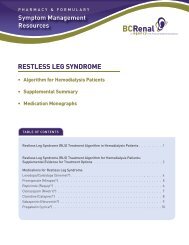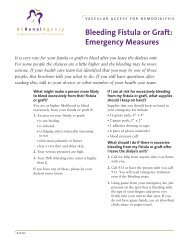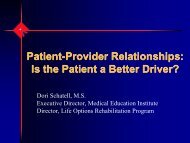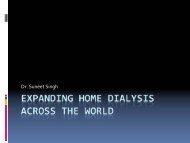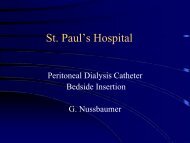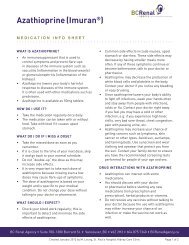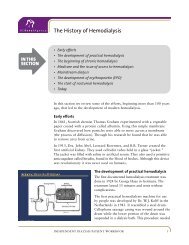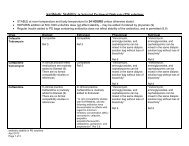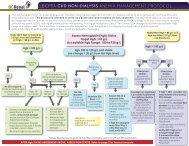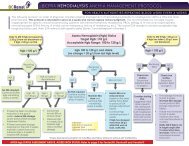Endotoxin Testing of Dialysis Water - BC Renal Agency
Endotoxin Testing of Dialysis Water - BC Renal Agency
Endotoxin Testing of Dialysis Water - BC Renal Agency
Create successful ePaper yourself
Turn your PDF publications into a flip-book with our unique Google optimized e-Paper software.
Clinical Practice Standards and Procedures for<br />
<strong>Dialysis</strong> <strong>Water</strong> Quality:<br />
2b: <strong>Endotoxin</strong> <strong>Testing</strong> <strong>of</strong> <strong>Dialysis</strong> <strong>Water</strong><br />
Section: HD Origin Date: November 2011<br />
Reviewed Date: November 2011<br />
PRINTED copies <strong>of</strong> Clinical Practice Standards and Procedures may not be the most recent version.<br />
The most current version is located on the <strong>BC</strong>PRA Website (www.bcrenalagency.ca)<br />
1.0 PRACTICE STANDARD<br />
1.1. Purpose<br />
The Biomedical Technologist, <strong>Renal</strong> <strong>Dialysis</strong> Technician, or <strong>Renal</strong> Nurse who is trained and has<br />
demonstrated competency in dialysis water practices will use the procedure outlined in this document to<br />
collect dialysis water samples for endotoxin testing, and to perform the necessary actions should test<br />
results for endotoxin levels exceed the acceptable limits.<br />
1.2. Standards (based on CSA-ISO)<br />
<strong>Dialysis</strong> water must not contain endotoxin contaminants at concentrations in excess <strong>of</strong> those specified in<br />
the following table:<br />
<strong>Endotoxin</strong> Concentration<br />
Action Level<br />
<strong>Dialysis</strong> <strong>Water</strong><br />
< 0.25 EU/mL<br />
0.125 EU/mL<br />
The laboratory assaying technique used for testing endotoxin levels must be as follows:<br />
Assaying Time<br />
Assaying Technique<br />
<strong>Dialysis</strong> <strong>Water</strong><br />
Within 4 hours <strong>of</strong> collection<br />
or 24 hours if immediately refrigerated<br />
Limulus amoebocyte lysate (LAL) test<br />
The quality <strong>of</strong> the dialysis water must be verified to meet these standards at the time <strong>of</strong> installation <strong>of</strong> the<br />
water treatment system. <strong>Dialysis</strong> water must be cultured weekly for new dialysis ROs for a minimum <strong>of</strong><br />
one month, or until a pattern has been established (i.e. two consecutive tests have met the standards).<br />
<strong>Dialysis</strong> water must also be cultured weekly if the acceptable limits are exceeded. For established ROs<br />
(including portable ROs), monitoring and testing the microbiology <strong>of</strong> dialysis water must be performed at<br />
least monthly (or as recommended by the manufacturer).<br />
2.0 DEFINITIONS AND ABBREVIATIONS<br />
Action level<br />
Bi<strong>of</strong>ilm<br />
Dialysate (standard)<br />
Concentration <strong>of</strong> a contaminant at which steps should be taken to interrupt<br />
the trend toward higher, unacceptable levels.<br />
Coating on surfaces that consists <strong>of</strong> microcolonies <strong>of</strong> bacteria embedded in a<br />
protective extracellular matrix. The matrix, a slimy material secreted by the<br />
cells, protects the bacteria from antibiotics and chemical disinfectants.<br />
Aqueous fluid containing electrolytes and usually buffer and glucose, which<br />
is intended to exchange solutes with blood during hemodialysis; also known
<strong>Dialysis</strong> water<br />
Disinfection<br />
<strong>Endotoxin</strong><br />
<strong>Endotoxin</strong> Units (EU)<br />
Hemodialysis<br />
HPC<br />
LAL<br />
LAL test<br />
Microbial<br />
Microbial contamination<br />
as dialysis fluid, dialyzing fluid, or dialysis solution.<br />
<strong>Water</strong> that has been treated to meet the requirements <strong>of</strong> the CSA-ISO<br />
standards and which is suitable for use in hemodialysis applications,<br />
including the preparation <strong>of</strong> dialysis fluid, reprocessing <strong>of</strong> dialysate,<br />
preparation <strong>of</strong> concentrates and preparation <strong>of</strong> substitution fluid for online<br />
convective therapies.<br />
Destruction <strong>of</strong> pathogenic and other kinds <strong>of</strong> microorganisms by thermal or<br />
chemical means.<br />
Major component <strong>of</strong> the outer cell wall <strong>of</strong> gram-negative bacteria. (See also<br />
pyrogen.)<br />
Units assayed by the LAL test when testing for endotoxins.<br />
Form <strong>of</strong> renal replacement therapy in which waste solutes are removed<br />
primarily by diffusion from blood flowing on one side <strong>of</strong> a membrane into<br />
dialysis fluid flowing on the other side.<br />
Heterotrophic Plate Count.<br />
Limulus amoebocye lysate.<br />
Assay used to detect pyrogens and measure endotoxin levels.<br />
Referring to microscopic organisms, such as bacteria, fungi, and algae.<br />
Contamination with any form <strong>of</strong> microorganism (e.g., bacteria, yeast, fungi,<br />
and algae) or with the by-products <strong>of</strong> living or dead organisms such as<br />
endotoxins, exotoxins and cyanobacterial toxins (derived from blue-green<br />
algae).<br />
Pyrogen A substance that can cause fever (elevation <strong>of</strong> body temperature above 37.8<br />
°C). Symptoms <strong>of</strong> a pyrogenic reaction may include chills, rigours, nausea,<br />
vomiting, and hypotension. (See also endotoxin.)<br />
RO<br />
Reverse osmosis.<br />
Disclaimer: The procedure steps may not depict actual sequence <strong>of</strong> events. Site-specific considerations may be<br />
made when applying the following procedures and protocols.<br />
3.0 EQUIPMENT<br />
<br />
<br />
<br />
<br />
4.0 PROCEDURE<br />
LAL Sample Kit (to be determined)<br />
Alcohol swabs<br />
Gloves<br />
<strong>Endotoxin</strong> <strong>Testing</strong> <strong>of</strong> <strong>Dialysis</strong> <strong>Water</strong> Log Sheet<br />
4.1 <strong>Dialysis</strong> water sample collection.<br />
Note: Samples should always be collected before cleaning/disinfection.<br />
4.1.1 Collect the sample from a point in the distal segment <strong>of</strong> the loop, immediately prior to<br />
where water returns to the RO, or immediately prior to where the water re-enters the<br />
storage tank, if one is present.<br />
For portable ROs, collect the sample from the outlet <strong>of</strong> the portable RO.<br />
4.1.2 The sample taps should be opened and the water should be allowed to run for at least 60<br />
seconds before a sample is collected in a LAL sampling unit.
4.1.3 Sample taps should not be disinfected. If insisted, a sterile gauze with alcohol should be<br />
used, and the sample should not be collected until all the alcohol has evaporated so as to<br />
leave no disinfectant residual in the sample. Bleach or other disinfectant solutions should<br />
not be used.<br />
4.1.4 Collect the appropriate amount (to be determined) <strong>of</strong> water, or the volume specified by the<br />
LAL Sample Kit, in the sampling unit.<br />
4.1.5 Record the sample location(s), date, time, and initials <strong>of</strong> the designated tester on the<br />
<strong>Endotoxin</strong> <strong>Testing</strong> <strong>of</strong> <strong>Dialysis</strong> <strong>Water</strong> Log Sheet.<br />
4.2 Perform the required LAL testing (to be determined).<br />
4.3 Upon getting the results, record the results and the date the results are obtained on the <strong>Endotoxin</strong><br />
<strong>Testing</strong> <strong>of</strong> <strong>Dialysis</strong> <strong>Water</strong> Log Sheet.<br />
4.4 Review the results.<br />
4.4.1 If the endotoxin concentration does not exceed the action level <strong>of</strong> 0.125 EU/mL, resume<br />
routine endotoxin testing <strong>of</strong> dialysis water the following month.<br />
Otherwise, take corrective measures (go to step 4.5).<br />
4.5 Perform corrective action (refer to Process Flowchart below).<br />
4.5.1 If this is the 1 st sample, retest within immediately (repeat steps 4.1 to 4.4.1).<br />
4.5.2 If this is the 2 nd sample, contact Biomed, if not already notified, to perform the next steps.<br />
4.5.2.1 If the endotoxin concentration exceeds 0.25 EU/mL, arrange an emergency<br />
disinfection (within 24 hours) <strong>of</strong> the RO using peracetic acid (i.e., Minncare)<br />
and notify the Nephrologist. Complete a PSLS report.<br />
Otherwise, arrange disinfection <strong>of</strong> the RO using peracetic acid within a week.<br />
4.5.2.2 Notify the Area <strong>Renal</strong> Manager, Biomed Risk & Quality, and the Biomed Lead<br />
Tech.<br />
4.5.2.3 Retest the system or portable RO after disinfection with peracetic acid (repeat<br />
steps 4.1 to 4.4.1).<br />
4.5.3 If this is the 3 rd (or more) sample, it is likely that bi<strong>of</strong>ilm is present in the water treatment<br />
system and must be removed.<br />
4.5.3.1 Contact the water treatment system vendor for guidance.<br />
4.5.3.2 Retest the system or portable RO (repeat steps 4.1 to 4.4.1).<br />
4.5.4 Record the corrective measure taken on the <strong>Endotoxin</strong> <strong>Testing</strong> <strong>of</strong> <strong>Dialysis</strong> <strong>Water</strong> Log<br />
Sheet.<br />
5.0 DOCUMENTATION CONSIDERATIONS<br />
All endotoxin test results for dialysis water must be recorded on the <strong>Endotoxin</strong> <strong>Testing</strong> <strong>of</strong> <strong>Dialysis</strong> <strong>Water</strong><br />
Log Sheet. These results must be reviewed by the Area <strong>Renal</strong> Manager and Infection Control, and<br />
reviewed and signed <strong>of</strong>f by the Nephrologist every month.<br />
6.0 SPECIAL CONSIDERATIONS<br />
<br />
<br />
<br />
<br />
<br />
While taking samples, it is important that no contact is made with the inside <strong>of</strong> the sampling unit.<br />
The procedure should be done when the system is under stable conditions representing normal<br />
operation.<br />
The procedure should not be done within a 2-hour period following a heat clean procedure as the<br />
sample may be too warm.<br />
If bacterial contamination is suspected, but water cultures are negative, it may be necessary to check<br />
for the presence <strong>of</strong> bi<strong>of</strong>ilm.<br />
Erratic colony counts may indicate the presence <strong>of</strong> bi<strong>of</strong>ilm since sloughing <strong>of</strong> bi<strong>of</strong>ilm may occur with<br />
release <strong>of</strong> bacteria into the water.
Refer to the Microbial <strong>Testing</strong> <strong>of</strong> <strong>Dialysis</strong> <strong>Water</strong> clinical standard for microbiological testing for<br />
bacteria.<br />
Refer to the <strong>Endotoxin</strong> <strong>Testing</strong> <strong>of</strong> Dialysate clinical standard for endotoxin testing <strong>of</strong> dialysate.<br />
7.0 REFERENCES<br />
CAN/CSA-ISO 11663-11 - Quality <strong>of</strong> dialysis fluid for hemodialysis and related therapies (Adopted<br />
ISO 11663:2009, First edition, 2009-04-15), Canadian Standards Association, 2011.<br />
CAN/CSA-ISO 13959-11 – <strong>Water</strong> for hemodialysis and related therapies (Adopted ISO 13959:2009,<br />
First edition, 2009-04-15), Canadian Standards Association, 2011.<br />
CAN/CSA-ISO 26722-11 – <strong>Water</strong> treatment equipment for hemodialysis applications and related<br />
therapies (Adopted ISO 26722:2009, First edition, 2009-04-15), Canadian Standards Association,<br />
2011.<br />
Dialysate for hemodialysis (ANSI/AAMI RD52:2004/(R)2010), Association for the Advancement for<br />
Medical Instrumentation, Arlington (VA), 2009.<br />
8.0 DEVELOPED BY<br />
Janise Galvey, Manager, IH Biomedical Engineering<br />
Provincial revisions - Dr. Myriam Farah<br />
9.0 REVIEWED BY<br />
IH <strong>Renal</strong> Biomedical Technologists and <strong>Renal</strong> Program Technicians and Managers<br />
NHA <strong>Renal</strong> Biomedical Technologists and <strong>Renal</strong> Program Technicians and Managers<br />
FHA <strong>Renal</strong> Biomedical Technologists and <strong>Renal</strong> Managers<br />
VIHA <strong>Renal</strong> Biomedical Technologists and <strong>Renal</strong> Managers<br />
PHC <strong>Renal</strong> Biomedical Technologists and <strong>Renal</strong> Managers<br />
10.0 ENDORSED BY<br />
<strong>BC</strong> Provincial Task Force for <strong>Dialysis</strong> <strong>Water</strong> Quality:<br />
Dr. Sue Bannerman<br />
Dr. Michael Copland<br />
Dr. Gerry Karr<br />
Dr. Myriam Farah<br />
Tim Rode<br />
Edith Davidson<br />
11.0 APPROVED BY<br />
<strong>BC</strong>PRA Medical Advisory Council – November 2011
12.0 PROCESS FLOWCHART<br />
<strong>Endotoxin</strong> <strong>Testing</strong> <strong>of</strong> <strong>Dialysis</strong> <strong>Water</strong> Process Flowchart<br />
A<br />
Perform LAL testing on samples<br />
(process to be developed)<br />
START: Designated tester* takes<br />
dialysis water samples from point in<br />
distal segment <strong>of</strong> loop. For portable<br />
ROs, sample is taken from outlet<br />
Record results on <strong>Endotoxin</strong> <strong>Testing</strong><br />
<strong>of</strong> <strong>Dialysis</strong> <strong>Water</strong> Log Sheet<br />
NO<br />
Results<br />
≥ 0.125<br />
EU/mL?<br />
YES<br />
Results are reviewed by<br />
the Area <strong>Renal</strong> Manager<br />
and Infection Control<br />
First<br />
sample?<br />
YES<br />
Retest immediately;<br />
retake samples<br />
A<br />
NO<br />
Results are reviewed<br />
and signed <strong>of</strong>f by the<br />
Nephrologist<br />
Contact Biomed<br />
Resume routine monthly<br />
endotoxin testing<br />
NO<br />
Results<br />
≥ 0.25<br />
EU/mL?<br />
Arrange<br />
disinfection <strong>of</strong><br />
RO using<br />
peracetic acid<br />
within a week<br />
YES<br />
Arrange emergency disinfection<br />
<strong>of</strong> RO using peracetic acid within<br />
24 hours and notify Nephrologist<br />
Complete PSLS report<br />
Notify:<br />
Area <strong>Renal</strong> Manager<br />
Biomed Lead Tech and Risk & Quality<br />
NO<br />
Third or<br />
more<br />
sample?<br />
YES<br />
Bi<strong>of</strong>ilm is likely<br />
present in the<br />
water treatment<br />
system and must<br />
be removed.<br />
Contact the water<br />
treatment system<br />
vendor for<br />
guidance<br />
*Note: Designated tester may be a Biomedical Technologist , <strong>Renal</strong> <strong>Dialysis</strong> Technician, or <strong>Renal</strong> Nurse, depending on the particular renal site.




